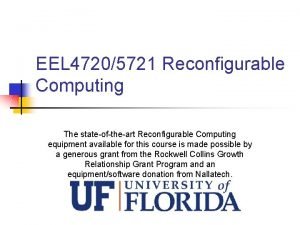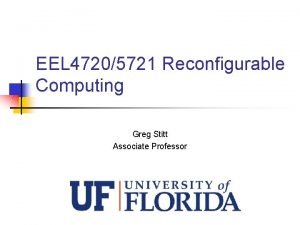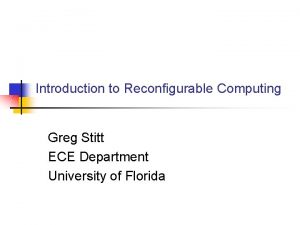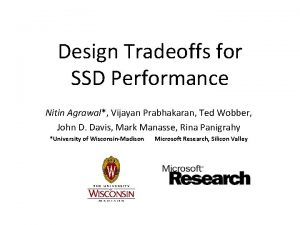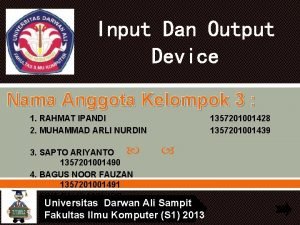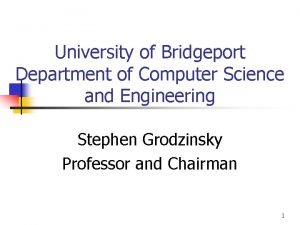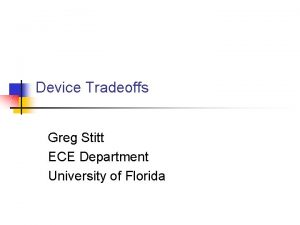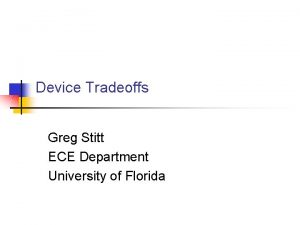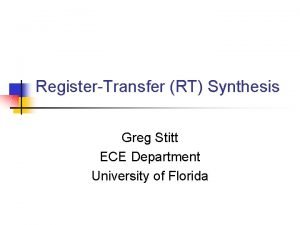Device Tradeoffs Greg Stitt ECE Department University of


















- Slides: 18

Device Tradeoffs Greg Stitt ECE Department University of Florida

When to use RC? n RC devices enable design of digital circuits without fabricating a device n n Therefore, RC can be used anytime a digital circuit is needed n Examples: ASIC prototyping, ASIC replacement, replacing/accelerating microprocessors But, when should be RC be used instead of alternative technologies? Implementation Possibilities Microprocessor RC (FPGA, CPLD, etc. ) ASIC Performance Why not use an ASIC for everything?

Moore’s Law n Moore's Law is the empirical observation made in 1965 that the number of transistors on an integrated circuit doubles every 18 months [Wikipedia] 1993: 1 Million transistors 2007: >1 BILLION transistors!!!! Becoming extremely difficult to design this - ASICs are expensive!

Moore’s Law n Solution: Make billions of transistors into a reconfigurable fabricate 1 big chip and use it for many things n Area overhead: circuit in FPGA can require 20 x more transistors n But, that’s still equivalent to a > 50 million transistor ASIC n n Pentium IV ~ 42 million transistors Modern FPGAs reportedly support millions of logic gates! 2007: >1 BILLION transistors!!!! Solution: Make this reconfigurable

When should RC be used? n 1) When it provides the cheapest solution n Depends on: n NRE Cost - Non-recurring engineering cost n n n Cost involved with designing application Unit cost - cost of a manufacturing/purchasing a single system Volume - # of units Total cost = NRE + unit cost * volume RC is typically more cost effective for low volume applications n n RC: low NRE, high unit cost ASIC: very high NRE, low unit cost

What about microprocessors? n Similar cost issues n µP (microprocessor) trends n n n low NRE cost (coding is cheap) Unit cost varies from several dollars to several thousand Wouldn’t cheapest microprocessor always be the cheapest solution? n Yes, but …

What about microprocessors? n Often, microprocessors cannot meet performance constraints n n e. g. video decoder must achieve minimum frame rate Common reason for using custom circuit implementation

Example n n n FPGA: Unit cost = 5, NRE cost = 200, 000 Microprocessor (µP): Unit cost = 8, NRE cost = 100, 000 Problem: Find cheapest implementation for all possible volumes (assume both implementations meet constraints) µP Cost FPGA 5 v+200 k = 8 v+100 k v = 33 k 200 k 100 k Volume 33 k Answer: For volumes less than 33 k, µP is cheapest solution. For all other volumes, FPGA is cheapest solution.

Example: Your Turn n FPGA n n ASIC n n Unit cost: 2, NRE cost: 3, 000 Microprocessor (µP) n n Unit cost: 6, NRE cost: 300, 000 Unit cost: 10, NRE cost: 100, 000 Problem: Find cheapest implementation for all possible volumes (assume that all possibilities meet performance constraints)

Another Example n FPGA n n ASIC n n Unit cost: 7, NRE cost: 300, 000 Unit cost: 4, NRE cost: 3, 000 Microprocessor (µP) n Cost Unit cost: 1, NRE cost: 100, 000 FPGA ASIC Answer: µP cheapest solution at any volume – not uncommon µP Volume

When should RC be used? n 2) When time to market is critical n Huge effect on total revenue RC has faster time to market than ASIC Growth Decline Revenue Total revenue = area of triangle Time to market Delayed time to market = less revenue

When should RC be used? n 3) When circuit may have to be modified n n n Can’t change ASIC - hardware Can change circuit implemented in FPGA Uses n When standards change n n n Codec changes after devices fabricated Allows addition of new features to existing devices Fault tolerance/recovery “Partial reconfiguration” allows virtual device with arbitrary size - analogous to virtual memory Without RC n Anything that may have to be reconfigured is implemented in software n Performance loss

How to choose a device? Determine architectures that meet performance requirements 1. n Not trivial, requires performance analysis/estimation - important problem n n 2. 3. n Will study later in semester And, other constraints - power, size, etc. Estimate volume of device Determine cheapest solution The best architecture for an application is typically the cheapest one that meets all design constraints.

RC Markets n Embedded Systems n n FPGAs appearing in set-top boxes, routers, audio equipment, etc. Advantages n RC achieves performance close to ASIC, sometimes at much lower cost n n Many other embedded systems still use ASIC due to high volume n Cell phones, i. Pod, game consoles, etc. Reconfigurable! n n If standards change, architecture is not fixed Can add new features after production

RC Markets n High-performance embedded computing (HPEC) n High-performance/super computing with special needs (low power, low size/weight, etc. ) n n n Satellite image processing Target recognition in a UAV RC Advantages n n Much smaller/lower power than a supercomputer Fault tolerance

RC Markets n High-performance computing (HPC) n Cray, SGI, DRC, Gi. DEL, Nallatech, Xtreme. Data n n Novo-G n n Combine high-performance microprocessors with FPGA accelerators 192 Altera Stratix III FPGAs integrated with 24 quad-core microprocessors RC advantages n HPC used for many scientific apps n n Low volume, ASIC rarely feasible, microprocessor too slow Lower power consumption n n Increasingly important Cooling and energy costs are dominant factor in total cost of ownership

RC Markets n General-purpose computing? ? ? n n Ideal situation: desktop machine/OS uses RC to speedup up all applications (similar to GPU trend) Problems n RC can be very fast, but not for all applications n n Generally requires parallel algorithms Coding constructs used in many applications not appropriate for hardware Subject of tremendous amount of past and likely future research How to use extra transistors on general purpose CPUs? n n n n More cache More microprocessor cores FPGA GPU Something else?

Limitations of RC n 1) Not all applications can be improved Embedded Applications – Large Speedups n n n Desktop Applications – No Speedup 2) Tools need serious improvement! 3) Design strategies are often ad hoc 4) Floating point? n Requires a lot of area, but performance is becoming competitive with other devices n Already superior in terms of energy
 Greg stitt uf
Greg stitt uf Greg stitt
Greg stitt Greg stitt
Greg stitt Hardware output komputer
Hardware output komputer Examples of tradeoffs
Examples of tradeoffs Scarcity forces tradeoffs symbol
Scarcity forces tradeoffs symbol Design tradeoffs for ssd performance
Design tradeoffs for ssd performance Wpi bme tracking sheet
Wpi bme tracking sheet Boston university ece
Boston university ece A tagout device is preferable to using a lockout device.
A tagout device is preferable to using a lockout device. Kelompok output
Kelompok output Department of law university of jammu
Department of law university of jammu Department of geology university of dhaka
Department of geology university of dhaka University of padova psychology department
University of padova psychology department University of bridgeport it department
University of bridgeport it department Iowa state math department
Iowa state math department Sputonik v
Sputonik v Texas state psychology
Texas state psychology Department of information engineering university of padova
Department of information engineering university of padova
